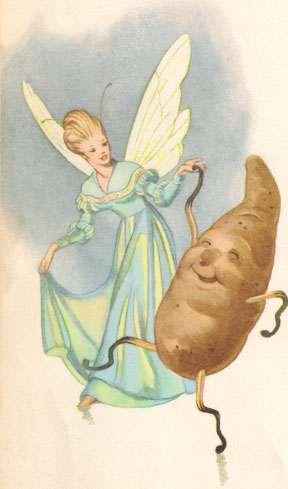Fairies and Potatoes September 21, 2013
Author: Beach Combing | in : Modern , trackbackA curious story from the beginning of that most slaughter of the innocents, the Irish potato famine. Dr Edgar, an Ulsterman is out and about with his friend Mr Brannigan, who later recalled the episode.
‘On the day after the examination of the Irish schools,’ continues Mr. Brannigan, ‘[Dr Edgar] took a walk with me on the Killala Road, when a man in an adjoining field attracted his attention. We wended our way to him, and, in answer to our inquiries, he informed us that he was searching for potatoes; but that, as others had been there before him on the same errand, it was nearly labour in vain — adding that he saw nothing but death before himself and the children. Dr. Edgar asked him for the loy, or spade; and, when it was presented to him, handled it as skilfully as if he had been trained to husbandry. He dug fully seven yards, and made several other experiments on spots around him. All the fields were then treated as common property, for the owners thought it only loss of time to turn over the soil. When the digging was completed, Dr Edgar gathered up the potatoes, carried them to St. Patrick’s Well adjoining, washed them there, tied them up in a silk pocket-handkerchief, and deposited the parcel in his pocket. On handing back the loy, he put a piece of silver into the hand of the poor man, who seemed confounded, not well knowing how to interpret what had just occurred.’
So far we just have a tame meeting just as the great hunger was starting to bite: what are the chances that the man and his family survived to the next year? But why is the man in the field so ‘confounded’ and why does he a moment later spit on the coin?
It was then currently believed in the neighbourhood that, in a pitched battle at Downpatrick Head, the Connaught fairies had been vanquished, and that the northern fairies had blighted, or rather carried off, the potato crop. The poor man, as I subsequently learned, after witnessing the odd performance of his odd-looking visitor — and particularly the washing of the potatoes in St. Patrick’s Well — was impressed with the idea that the dark-visaged stranger might be the commander-in-chief of the victorious gentry, and that it would be prudent to beware of him. But the piece of silver, under the circumstances, was a temptation too strong for him to resist. He therefore turned his back on us, and after spitting on the coin by way of precaution, lodged it in his pocket.
Spitting in Ireland was a way of keeping evil away. Other fairy stories from the famine: drbeachcombing AT yahoo DOT com
1 Oct 2013: Borky writes in: First you have the supernatural war over crops and the disastrous nutritional consequences of losing then you have the identification of Dr Edgar with the victorious fairies commander-in-chief much like the military style figure Captain figure who summons the wearers of the caul but you also have a hint of the death component in that the father’s so completely fixated on the idea of him and his kids dying he’s both convinced he won’t find any potatoes and utterly entranced by the seemingly magical way Edgar seems to almost conjure ’em out the ground. It also makes me wonder if the Abundia/Satia component of Ginzburg’s thesis namely the supernatural raids on household larders and wine cellars didn’t partly arise as both a Robin Hood like cult based on alleviating poverty/famine [much as raiding between Arab tribes functioned as a redistribution of property mechanism] but also as a social stress alleviating mechanism to avoid retribution by the haves on the have-nots leading to endless tit-for-tat massacres and the disintegration of the entire social structure. Thanks Borky!



